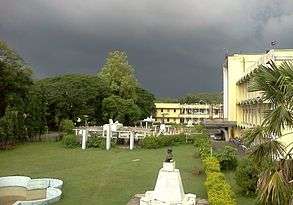Vidisha
Vidisha is a city in the state of Madhya Pradesh, India, located near the state capital Bhopal. Vidishā is the administrative headquarters of Bhelsa during the medieval period.
Geography
Vidisha is located at 23°32′N 77°49′E / 23.53°N 77.82°E.[1] It has an average elevation of 424 metres (1391 feet).
Demographics
As of 2011 India census,[2] Vidisha had a population of 155,959. Males constitute 53.21% of the population and females 46.79%. Vidisha has an average literacy rate of 86.88%, higher than the national average of 74.04%: male literacy is 92.29%, and female literacy is 80.98%. In Vidisha, 15% of the population is under 6 years of age.
Historic places and monuments


Near the eastern edge of the old town are the remains of a large temple of the late Paramara period known as the Bijamaṇḍal. The building was probably started in the second half of the 11th century. That it was never finished is shown by carved niches and unfinished architectural pieces found round the base of the temple plinth.[3] On top of the plinth is a small mosque made using pillars, one of which has an inscription dating probably from the time of king Naravarman (circa 1094-1134). It is a devotional inscription revering Carccikā (i.e. Cāmuṇḍā), of whom he was a devotee.[4] The miḥrāb suggests the mosque was constructed in the late 14th century. To one side of the Bijamaṇḍal is a store house of the Archaeological Survey of India containing many sculptures collected in the neighbourhood. A step-well of the 7th century is in the same campus and has, beside the entrance, two tall pillars with Kṛṣṇa scenes. These are the earliest Kṛṣṇa scenes in the art of central India.
History
The town is situated east of the Betwa River, in the fork of the Betwa and Bes rivers, 9 km from Sanchi. The town of Besnagar, 3 km from present-day Vidisha on the west side of the river, became an important trade centre in the 6th and 5th centuries BCE, under the Shungas, Nagas, Satavahanas, and Guptas, and was mentioned in the Pali scriptures. The Emperor Ashoka was the governor of Vidisha during his father's lifetime. His Buddhist Empress Vidisha Devi who was also his first wife was brought up in Vidisha. It finds mention in Kalidasa's Meghdoot.
Lord Rama is believed to have come here. His foot impressions are still there which were kept safe by the people and are now properly constructed. They are popularly known as "Charan Teerth" at one of the ghats of river Betwa.
Emergence as Bhelsa
Besnagar was abandoned in the 6th century. It came into prominence again as Bhelsa during the medieval period. It became famous for the temple of Sun god Bhillasvanin.[5] It was ruled by the Later Gupta king Devagupta and Rashtrakuta king Krishna III. The name is first noted in an inscription of 878 AD by a merchant Hatiaka of Paravada community.[6] The 12th century Tri-shashthi-shalaka-purusha-charitra mentions an image of Bhillasvamin at Vidisa, along with a copy of Jivant Swami buried in the sand.[7] Minhajuddin's Tabaqat-i-Nusiri states that the temple was destroyed by Iltutmish in A D. 1233-34.[8]
Allauddin Khilji, then the nephew of the Sultan, captured and sacked Bhelsa in 1292. [9] In 1532 Bhilsa was sacked by Bahadur Shah of Gujarat. It thus, passed on to the Malwa Sultans and then to the Mughals and the Scindias.
Notable persons
Born in Vidisha Kailash Satyarthi won the 2014 Nobel Peace Prize.[10]
Transport

Vidisha is a railway station on the Delhi-Chennai, Delhi-Mumbai main line of the Central Railway, at a distance of 54 km from Bhopal, the capital of Madhya Pradesh. Sanchi on the Jhansi-Itarsi section of the West Central Railway and Bhopal to Bina triple electrified broad gauge lines,from Bina to Katni double electrified Lines, Vidisha 102 km from Bina, and Vidisha, 9 km from Sanchi, are more convenient.
References
- ↑ Falling Rain Genomics, Inc - Vidisha
- ↑ "Census of India 2001: Data from the 2001 Census, including cities, villages and towns (Provisional)". Census Commission of India. Archived from the original on 2004-06-16. Retrieved 2008-11-01.
- ↑ O. P. Mishra, "Bijamaṇḍal and Carccikā: Tutelary Goddess of the Paramāra King Naravarman," Journal of the Royal Asiatic Society 22, 1 (2012), pp. 107–113.
- ↑ H. V. Trivedi, Inscriptions of the Paramāras, Chandellas, Kachchhapaghātas and Two Minor Dynasties, Corpus Inscriptionum Indicarum, volume 7 in 2 parts (New Delhi, 1978-91) 2: 120-22.
- ↑ Art & architecture of Daśārṇa (Malwa) Region, Rahman Ali, Sharada Pub. House, 2008, p. 14
- ↑ (Malwa Through the Ages, from the Earliest Times to 1305 A.D, K.C. Jain, p. 485
- ↑ Gleanings of Indian archaeology, history, and culture: Prof. Dr. R.N. Mehta commemoration volume, Volume 1, 2000, p. 263
- ↑ Madhya Pradesh: District Gazetteers, Volume 42, V. S. Krishnan, Government Central Press p.30
- ↑ [Studies in the Religious Life of Ancient and Medieval India, Dineschandra Sircar, Motilal Banarsidass Publ., 1971, p. 117]
- ↑ "10 things to know about Noble Prize winner Kailash Satyarthi". Zee News.